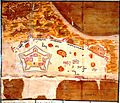Real Felipe Fortress facts for kids
Quick facts for kids Real Felipe Fortress National Monument |
|
|---|---|

Frontal view of the Real Felipe Fortress
|
|
| Location | Central part of the bay of Callao, Peru |
| Area | 70,000 m² |
| Built | 1747–1774 and 1776–1811 |
| Governing body | Peru's Army |
| Designated | 19 May 1952 |
| Lua error in Module:Location_map at line 420: attempt to index field 'wikibase' (a nil value). | |
The Real Felipe Fortress was built to defend the main Peruvian port and the city of Lima from pirates and corsairs during colonial times. The fortress was pivotal in the 1826 naval battle between a Spanish fleet sent to South America to "reclaim" its colonies and land batteries in the coast of Peru. The Real Felipe Fortress is currently the Peruvian Army Museum, displaying historical uniforms, weapons and other military paraphernalia.
History
Background
During the Viceroyalty of Peru, Callao was the main port of the Americas, it connected the colonies with Spain. Due to the lack of adequate defenses, several pirate incursions took place. In an attempt to protect the port, the viceroy Pedro Álvarez de Toledo y Leiva decreed the construction of the Walls of Lima between the years 1640 and 1647 to protect the city. However, the 1746 Lima–Callao earthquake, destroyed most of the fortifications. Viceroy José Antonio Manso de Velasco, ordered the contraction of the fortress to bolster the defense of the port.
Construction
In 1746, the design proposal of French architect Louis Godin was selected as the design of the fortress. Construction of the fortress began on 21 January 1747 and the first stone was erected 1 August of the same year. This was considered one of the most important constructions made by Spain in the New World, costing about three million pesetas. Most of the stone came from San Lorenzo Island and from the ruins caused by the earthquake. The name of the fortress was chosen to honor the Spanish king Felipe V from the House of Bourbon, who had recently died. Construction ended during the reign of viceroy Manuel de Amat y Junient in 1774.
In 1782, viceroy Manuel Guirior decided to bolster the defences of the fortress with the construction of two smaller complementary fortresses; the «San Miguel» and the «San Rafael». This system came to be known as «Los Castillos del Callao» (The castles of Callao).
Independence Era
In 1806, viceroy José Fernando de Abascal y Sousa ordered the construction of a storage depot for arms, artillery and water to supply up to 2,000 soldiers for up to four months. On 21 January 1816, Admiral Guillermo Brown blockaded the port of Callao, captured several royalist boats and proceeded to bombard the port. However, they were soon repulsed by the coastal batteries of the fortress.
During 16 January 1819, the fortress repulsed an attack from Admiral Lord Thomas Cochrane during the government of viceroy Joaquín de la Pezuela. This incident forced General José de San Martín to invade Lima from Pisco. Once the declaration of independence was decreed, General San Martín ordered to siege the fortress. The siege ended in 1821, when royalist General José de La Mar surrendered to Republican forces. However, the fortress was captured again by the Spaniards under Brigadier José Ramón Rodil y Campillo. Only in 1826, would the fortress return to the republicans after Brigadier Rodil y Campillo surrendered and ended the Second siege of Callao.
Gallery
See also
 In Spanish: Fortaleza del Real Felipe para niños
In Spanish: Fortaleza del Real Felipe para niños








